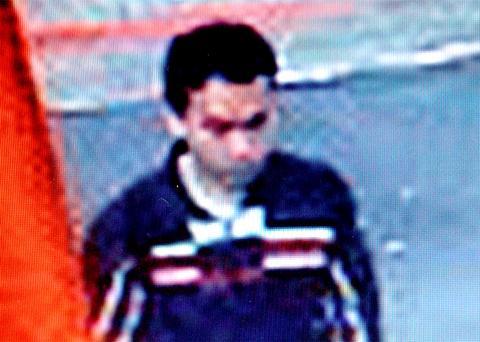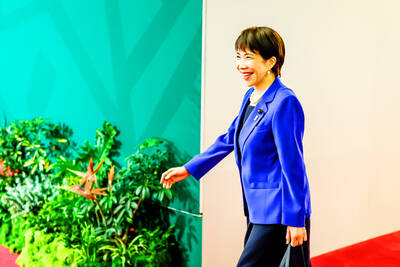Taipei police last night nabbed a man who was believed to be the "rice bomber," but the police declined to confirm whether the suspect was indeed the criminal.
"Since the man is still under interrogation, we can't tell whether he is the rice bomber," a police source said.

PHOTO: TAIPEI CITY POLICE DEPARTMENT
According to the source, the man perfectly fits the physical characters shown in the photos released by the police on Wednesday.
The Taipei Police Department's Criminal Investigation Corps (CIC) on Wednesday released a picture of a suspect who could be the notorious "rice bomber," and announced an NT$500,000 reward to anyone who could provide information that leads to the bomber's arrest.
The picture of the suspect was captured from video footage from a security camera at the corner of Taipei City's Zhongshan S Road at 5:17pm on Nov. 11. The police believe that, when the video footage was taken, the suspect must have just finished planting the bomb, which exploded in front of the Ministry of Education the following day.
"We have reviewed all the video footage and talked to all the witnesses who might have seen the suspect before we decided the man in the picture could be him," said Hsu Hung-ping (
In the picture, the man appears to be in his early 20s and approximately 165cm to 170cm tall. Officers said that the suspect would change clothes after he committed a crime, before he left the scene.
"If you have any related information, please call 02-2381-7409, 02-2767-6676, 0910-222-432 or 0931-770-110 to reach the police," Hsu said.
Ever since the rice bomber's first case on Oct. 27 last year, there have been 13 rice-bomber-related cases in the city. The rice bomber has admitted to at least eight of them.
"He always alerts the media and the police every time he commits a crime," Hsu said.
The suspect earned the moniker "rice bomber" because he always leaves behind a letter and a small packet of rice along with the explosive device.
In one letter, the rice bomber claimed that he is a protester who wants to urge the government to stop importing rice and start protecting local rice farmers. The bomber has claimed that the bomb attack on a train from Keelung to Chunan on Feb. 2 was his work, as well as seven attacks in Taipei City since Oct. 27 last year.
The first "rice bomb" was found in Da-an Forest Park on Oct. 27 last year, and another bomb was found on Nov. 13 in one of the park's men's restrooms. On Nov. 22, another bomb was discovered in front of the Ministry of Finance's Financial Data Center.
On Dec. 2, a fourth bomb was discovered in the MRT's Guting Station, while on Dec. 10 and Dec. 23 two more bombs appeared in Taipei's Hsinsheng and Yucheng parks.
However, none of the "rice bombs" -- including the bombs that actually exploded -- have injured anyone.

LIMITS: While China increases military pressure on Taiwan and expands its use of cognitive warfare, it is unwilling to target tech supply chains, the report said US and Taiwan military officials have warned that the Chinese People’s Liberation Army (PLA) could implement a blockade within “a matter of hours” and need only “minimal conversion time” prior to an attack on Taiwan, a report released on Tuesday by the US Senate’s China Economic and Security Review Commission said. “While there is no indication that China is planning an imminent attack, the United States and its allies and partners can no longer assume that a Taiwan contingency is a distant possibility for which they would have ample time to prepare,” it said. The commission made the comments in its annual

DETERMINATION: Beijing’s actions toward Tokyo have drawn international attention, but would likely bolster regional coordination and defense networks, the report said Japanese Prime Minister Sanae Takaichi’s administration is likely to prioritize security reforms and deterrence in the face of recent “hybrid” threats from China, the National Security Bureau (NSB) said. The bureau made the assessment in a written report to the Legislative Yuan ahead of an oral report and questions-and-answers session at the legislature’s Foreign Affairs and National Defense Committee tomorrow. The key points of Japan’s security reforms would be to reinforce security cooperation with the US, including enhancing defense deployment in the first island chain, pushing forward the integrated command and operations of the Japan Self-Defense Forces and US Forces Japan, as

IN THE NATIONAL INTEREST: Deputy Minister of Foreign Affairs Francois Wu said the strengthening of military facilities would help to maintain security in the Taiwan Strait Japanese Minister of Defense Shinjiro Koizumi, visiting a military base close to Taiwan, said plans to deploy missiles to the post would move forward as tensions smolder between Tokyo and Beijing. “The deployment can help lower the chance of an armed attack on our country,” Koizumi told reporters on Sunday as he wrapped up his first trip to the base on the southern Japanese island of Yonaguni. “The view that it will heighten regional tensions is not accurate.” Former Japanese minister of defense Gen Nakatani in January said that Tokyo wanted to base Type 03 Chu-SAM missiles on Yonaguni, but little progress

NO CHANGES: A Japanese spokesperson said that Tokyo remains consistent and open for dialogue, while Beijing has canceled diplomatic engagements A Japanese official blasted China’s claims that Japanese Prime Minister Sanae Takaichi has altered Japan’s position on a Taiwan crisis as “entirely baseless,” calling for more dialogue to stop ties between Asia’s top economies from spiraling. China vowed to take resolute self-defense against Japan if it “dared to intervene militarily in the Taiwan Strait” in a letter delivered Friday to the UN. “I’m aware of this letter,” said Maki Kobayashi, a senior Japanese government spokeswoman. “The claim our country has altered its position is entirely baseless,” she said on the sidelines of the G20 summit in Johannesburg on Saturday. The Chinese Ministry